
Chapter 5 -- METEOROLOGY
The meteorology of Mars is a subject of great interest to the A.L.P.O. Mars Section and will be of prime importance for study in future apparitions of Mars. The late Chick Capen was especially fond of writing about the Martian weather and how to observe Martian atmospheric phenomena. The special interest he had in the study of Martian meteorology was an indicator of its importance in the understanding of our Solar System.
It is well known that the Martian atmosphere is very dynamic, exhibiting several types of clouds and hazes that are easily detected with the aid of color filters and modest-sized telescopes. White water clouds, local yellow dust clouds, global dust storms, bluish limb hazes, and bright surface ice-fogs and frosts have been studied with increased interest in the past decade. Observations of these meteorological features indicate their behavior and occurrence is most often coupled with the seasonal sublimation and condensation of polar-cap material. An intensive statistical meteorology study program was completed at the Institute for Planetary Research Observatories (I.P.R.O.), utilizing quality visual and photographic data obtained during each apparition by the A.L.P.O. International Mars Patrol (IMP) programs.
Although the Martian sky appears quite clear, transient bright streaks and oval patches are often observed in its atmosphere that exhibits similar characteristics to clouds and hazes seen in the Earth’s atmosphere. Fine dust particles, CO 2 and/or H 2 O hazes and ice crystals are regularly observed in Mars’ atmosphere using moderate telescopes. Telescopes of 8 to 16 inches in aperture can produce useful information about Mars if used in an aggressive and systematic manner with the aid of color filters.
From the data gathered by the Mariner and Viking Lander/Orbiter spacecraft, we know that H 2 O and CO 2 condensates do exist in the atmosphere of Mars and we are comfortable with the idea that-- what we observe as bright patches on Mars are in fact atmospheric clouds, fogs, and/or hazes. Although no current information is received from these spacecraft, their mission data continue to give us considerable close-up information about Mars. They have identified or confirmed most of the telescopically observed features and meteorological phenomena recorded by astronomers for over three centuries. More importantly, results from these space missions have defined and outlined areas for continued future telescopic research. Because these spacecraft are no longer in operation, the only future knowledge of Martian changing phenomena for mankind will come from Earth-bound telescopes.
A most delicate and challenging feat of observation is the detection of volatiles at the boundary between the Martian atmosphere and its surface. In this volatile regime, ice-fogs and frosts, often called bright patches, can be distinguished from elevated clouds by means of comparing their relative brightnesses and boundary definitions as seen with the aid of blue, blue- green, green, and yellow filters. If the suspect bright feature appears brighter in blue light than it does in green or yellow light, it is an atmospheric cloud. If it is brighter and better defined in blue-green light than in blue or yellow light, it is probably ice-fog contiguous to the surface. If the patch appears brighter with sharp boundary in green and yellow light and is not well seen in blue light, it can be identified as surface frost.
A boundary-layer volatiles diurnal behavior and location also helps to distinguish it from clouds and limb haze. Fogs and frosts form in the chill of the Martian night, rotate with the planet, dissipate in the morning sunlight, and usually disappear by local noon. Fogs normally form in valleys, in fossae (linear depressions), basins, and on upper slopes. Frosts are usually noted on cool, light albedo features, plana (plateaus), montes (mountains), and floors of large craters. Because these volatiles are topographically controlled the discovery of their locations and seasonal occurrence is most important to the study of Martian weather patterns and areography.
The chapter ends with results from the Meteorological Survey conducted by author Beish over a 10-year study. This chapter contains many useful tables and graphs for statistical analysis of Martian atmospheric phenomena during the observing periods from 1964-1988.
CLOUDS AND HAZES
The Martian atmosphere is ever-changing, see Atmosphere of Mars. White water ice clouds, yellowish dust clouds, bluish limb hazes, and bright surface frosts have been studied with increasing interest in the past two decades. Clouds seem to be related to the seasonal sublimation and condensation of polar-cap material. The A.L.P.O. Mars Section, using visual data and photographs from professionals and amateurs around the world, has conducted an intensive study of Martian meteorology. The first report, published in 1990, analyzed 9,650 IMP observations submitted over eight Martian apparitions between 1969 and 1984 [ Beish and Parker , 1990]. This study has now been expanded to include 24,130 observations made between 1965 and 1995 [ Beish , 1999]. Statistical analysis indicates that discrete, water ice crystal cloud activity and surface fog occurrences are significantly higher in the spring and summer of the Martian northern hemisphere than they are during the corresponding seasons in the southern hemisphere.
Arctic and Antarctic Meteorology is of special interest to the planetary meteorologist. Considerable frozen water is contained in the polar caps and contributes to the Martian atmospheric clouds and hazes as the spring and summer cap thaw becomes more rapid. Many interesting cloud or fog formations appear at the Northern Polar Region (NPR) during late spring as the sub- solar point rises higher in the Martian latitudes. The following Mars charts will be helpful to locate regions on Mars discussed in the text that follows:
New ALPO Mars Section Mars Chart:
Mars_Map_Venable-Melka.jpg
ALPO Mars Section Mars Chart: Alpomarsmap.jpg
Ebasawa Mars Chart: Ebasawamars.jpg
The Mars Climate Database: http://www-mars.lmd.jussieu.fr/mars/mars.html
Discrete Topographic and Orographic Clouds have been observed on Mars for over a century. In 1907, a remarkable, recurring W-shaped cloud formation was observed each late-spring afternoon in the Tharsis-Amazonis region [ Slipher , 1962]. A decade later, C.F. Capen proposed that the W-clouds are orographic (mountain-generated), caused by the up-lifting of water vapor-laden atmosphere. [ Capen , 1984 and Capen , 1986]. In 1971, the Mariner 9 spacecraft probe confirmed these observations, and showed that they were water clouds near the large volcanoes Olympus Mons (133° W, 18° N), Ascraeus Mons (104° W, 11° N), Pavonis Mons (112° W, 0° N), and Arsia Mons (120° W, 9° S). Although often observed without filters, these clouds are best seen in blue or violet light when they are high in the Martian atmosphere, and in yellow or green light when they are at very low altitudes. Similar orographic clouds are also frequently observed over the Elysium Shield region.

Approaching local Martian noon, discrete white orographic clouds, identified as water clouds by the Mariner 9 spacecraft, are seen in Martian spring and summer forming on the upper slopes of the large volcanoes Olympus Mons 113° W, 18° N), Ascraeus Mons (104° W, 11° N), Pavonis Mons (112° W, 0°), Arsia Mons (120° W, 09° S), and Elysium Mons (212° W, 25° N), and between Tharsis Tholus and Valles Marineris (80° - 100°W, 04° N). These seasonal clouds ("W-clouds") were well observed during northern summer (120° - 160° Ls) in 1984 and in 1986 after rapid thawing of the North Polar Cap (NPC) began (204° - 209° Ls).Figure 5-1. Images of Mars showing W-clouds over Tharsis volcanoes in 1999. Image A (left) by Don Parker, B (center left) by David Moore, C (center Right) by Maurisio Di Sciullo, and D (right) Antonia J. Cidadao.
In the future, it will be interesting to learn if these orographic clouds occur twice each Martian year, because they originate in the equatorial region of the planet. Look for them after the large southern basins, Hellas and Argyre, have lost their whiteness and have returned to a dark-ocher hue, and during the rapid retreat of the South Polar Cap (SPC) from southern mid-Spring until Summer (235° - 270° Ls). Because of the observed appearance and seasonal behavior of the great southern basins, the authors suspect that they act as "cold traps" during Mars’ southern Autumn and Winter, thus controlling the water vapor in that hemisphere. Because orographic clouds are best seen through blue and violet filters, they are well elevated and are probably generated by mechanical uplift, and growing by convection.
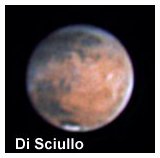
Figure 5-2. Images of Mars showing W-clouds on morning limb over Tharsis. Image by Maurisio Di Sciullo (Florida), 03 April 1999 0721UT (119 ° Ls, CM 73 ° ).
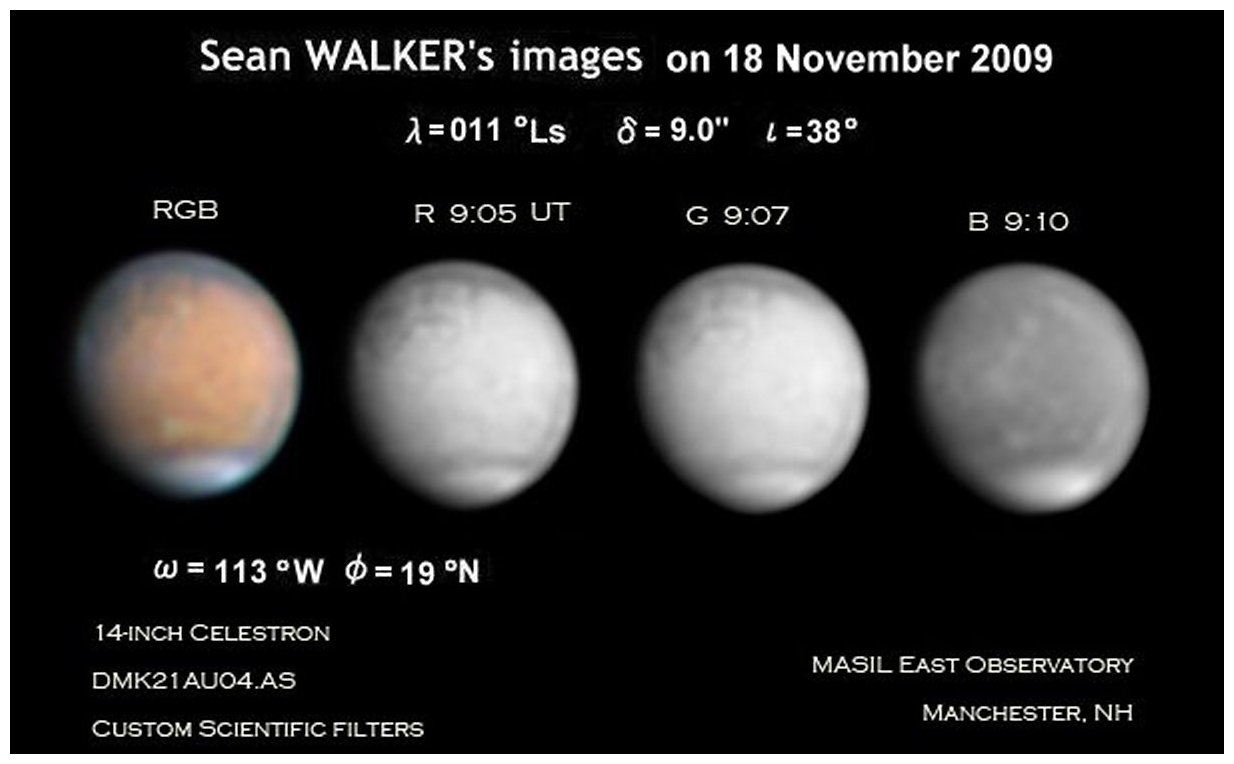
In addition to such dramatic orographic clouds, Mars exhibits
many localized, discrete clouds. These rotate with the planet
and are most often seen in northern spring-summer over Libya,
Chryse, and Hellas. One remarkable example of such a discrete
topographic cloud is the "Syrtis Blue Cloud", which
circulates around the Libya basin and across Syrtis Major,
changing the color of this dark albedo feature to an intense
blue. Originally named the "Blue Scorpion" by Fr.
Angelo Secchi in 1858, this cloud usually makes its appearance
during the late spring and early summer of Mars’ northern
hemisphere. It was prominent during the 1995 and 1997
apparitions and is best seen when the Syrtis is near the limb.
Viewing this cloud through a yellow filter causes the Syrtis to
appear a vivid green (yellow + blue = green).
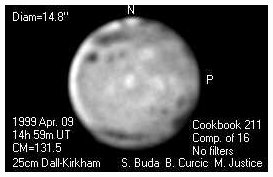
Figure 5-4. Image of Mars showing orographic clouds over Tharsis volcanoes in 1999 before they connected to form the W-clouds. Formation suggests a "Domino effect" by observers. Image by S. Buda and C. Justice.
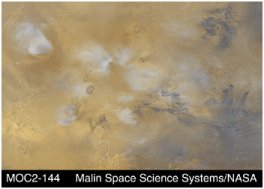
Figure 5-5. Mars Global Surveyor Mars Orbiter Camera Image of W-Clouds forming over the Tharsis region of Mars.
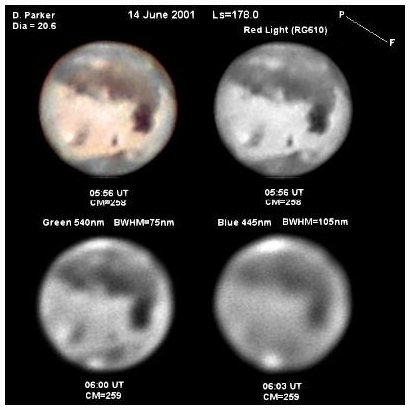
Figure 5-6 Ground-based images of Mars showing both orographic clouds forming over the Elysium and topographic clouds in Libya and Hellas. Image by D. Parker.
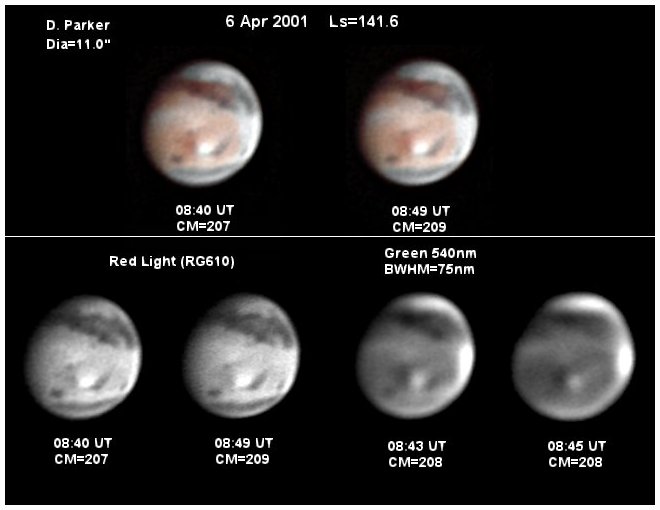
Figure 5-7. Ground-based images of Mars showing both orographic clouds forming over the Elysium and topographic clouds in Zephyria. Notice morning limb clouds forming east of Syrtis Major in Isidis Regio and Libya. Image by D. Parker.
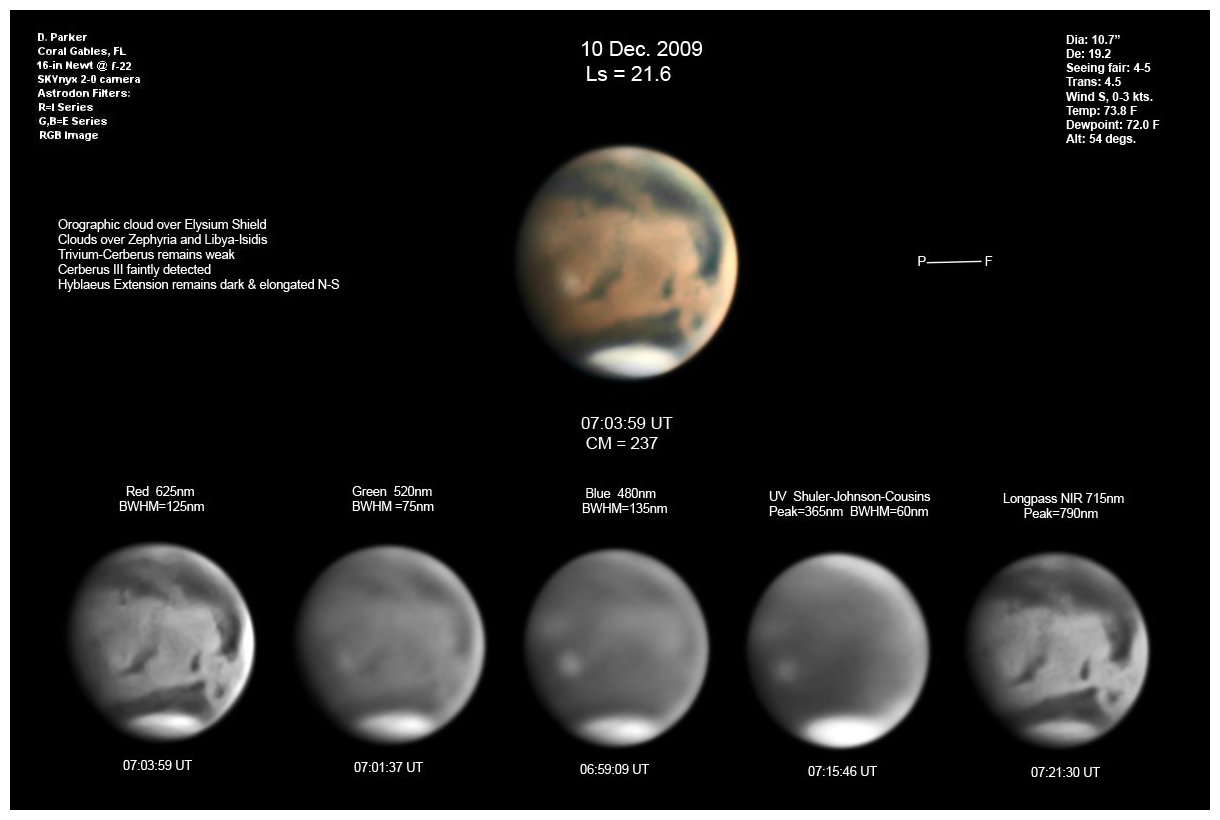
Figure 5-8. Ground-based images of Mars showing orographic clouds forming over the Elysium Planitia region; most likely over the volcano Hecates Tholus. Image by D. Parker.
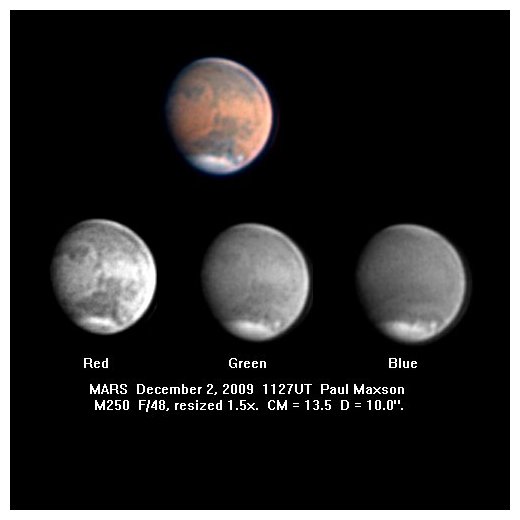
Limb brightening ("limb arcs") are caused by scattered light from dust and dry ice particles high in the Martian atmosphere. They should be present on both limbs, often throughout the apparition, and are also best seen in blue-green, blue or violet light. When dust is present, these arcs are often conspicuous in orange light. They appear as a defuse arc on either limb and are caused by the observer’s oblique view through the equivalent of several Martian atmospheres of aerosols, which may consist of CO2 crystals, fine dust, cirrus-type water clouds, or a mixture of these. Consequently, the observation of the global location, color, and density of limb haze is a very sensitive method of diagnosing the global system of Martian weather and unusual polar phenomena. Sometimes, the color and density of the hazes help to detect dust storms that have begun on the other side of the planet.Figure 5-9. Images of Mars showing a classical orographic cloud named Nix Tanaica (bright spot just southwest of the NPC). Image by Paul Maxson.
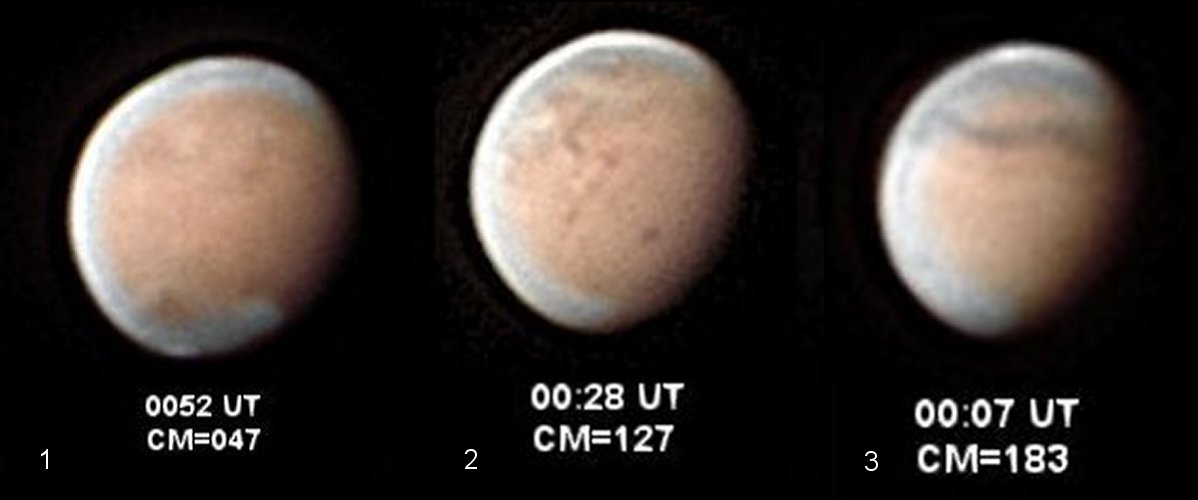
Figure 5-10. Images of Mars by D. Parker showing how dust storms can affect the limb areas of Mars. 1) Taken in August, 2001 after planet-encircling dust storm indicates dense north and south polar haze, morning limb haze and dense northern morning hazy area. 2) September, 2001 image with bright morning and polar limb hazes. 3) October, 2001 Mars still has bright limb hazes several months after the dust storm.
Morning
clouds, often called
"limb arcs", are bright, isolated patches of
surface fog or frost near the morning limb. The fogs usually
dissipate by mid-morning, while the frosts may persist most of
the Martian day, depending on the season. These bright features
are best viewed with blue-green, blue, or violet filters.
Occasionally, very low morning clouds can also be seen in green
or yellow light. Morning (sunrise) hazes are slightly larger,
extending 20° to 30° away from the limb. Limb hazes appear as a
thin and smooth arc, which often cover 50 to 90 degrees in
latitude, however, at times they are observed to extend from
pole to pole. Limb haze may be seasonal or non seasonal and,
since it does not rotate with the planet, disappears around
local 8 or 9 A.M., Mars time. It is best seen in violet light
if at high altitudes, or in blue light if at
mid-altitudes.
Evening clouds have the same appearance as morning clouds but are usually larger and more numerous than the latter. They appear as isolated bright patches over light desert regions in the late Martian afternoon and grow in size as they rotate into the late evening. They are best seen in blue or violet light. Evening (sunset) hazes are often observed as a thin haze, which can extend 10° to 20° away from the limb.
The size and frequency of limb clouds appear to be related to the regression of the northern, rather than the southern, polar cap. Both limb arcs and limb clouds are prominent after aphelion (70° Ls), but limb clouds tend to decrease rapidly in frequency after early summer, while limb hazes become more numerous and conspicuous throughout the northern summer.

Figure 5-11. Images of Mars showing LEFT: D. Peach’s image with morning limb haze, north polar haze and haze over Hellas. CENTER: T. Kumamori’s image showing morning and evening limb hazes with prominent north polar haze and clouds. RIGHT: D. Parker’s image featuring evening limb cloud and limb haze, morning limb haze, evening and morning limb clouds in northern latitudes with north polar hood and hazes. Also, classical orographic W-clouds.Equatorial Cloud Bands (ECB) appear as broad, diffuse hazy bands along the Martian equatorial zone and are difficult to observe with ground-based telescopes. CCD images and the HST have revealed that these clouds may be more common than suspected in the past. Their prevalence during the 1997 apparition led some conferees at the Mars Telescopic Observations Workshop-II (MTO-II) to postulate that many limb clouds are simply the limb portions of ECBs. A.L.P.O. astronomers are encouraged to watch for these elusive features during each apparition. Are they really more common, or could it be that our improved technologies merely allow us to detect them more easily?
Figure 5-12. HST images of Mars in 1997 showing a variety of cloud types from 1) UPPER LEFT: limb clouds on both limbs and south limb haze, 2) UPPER RIGHT : both limbs cloudy with cloud bands across equator region, 3) LOWER LEFT : orographic clouds over Olympus Mons and W-clouds forming on the evening limb with morning limb hazes, and 4) LOWER RIGHT : orographic cloud in Elysium with a large topographic cloud system over Hellas. Notice also a wide cloud band across equatorial zone.
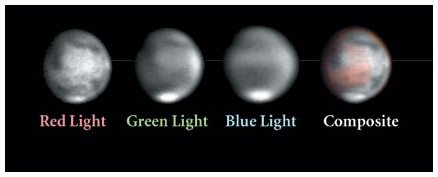
Figure 5-13. Ground-based images of Mars showing cloud bands across equator zone. Notice the morning limb clouds forming in Chryse and topographic clouds in Aria. Image by D. Parker.
New technologies, such as CCD cameras,
sophisticated computer hardware and software, and large
aperture planetary telescopes have resulted in a virtual
explosion in advancing the study of our Solar System. Never
before have we been able to readily detect the delicate wispy
Equatorial Cloud Bands on Mars as well as we can now with CCD
imaging.
The ECB is a faint violet or blue-white band of high altitude ice crystals that appears as a broad and diffuse hazy streak crossing within +/- 20 degrees of the Martian equatorial zone. Cloud bands are probably composed of thin water (H 2 O) ice crystals carried aloft by high altitude winds [ Wolff, et al , 1999] [ Hale, et al , 2003] [ Hale, et al , 2005]. ECBs are best observed visually through a deep-blue (W47 and W47B) Wratten filters and may be photographed or imaged in blue or ultraviolet light. Cloud Bands are observed most often during the Martian Northern Summer, however, with the limited data available the behavior of these clouds remains speculative. Systematic violet filter observations will someday unravel the mystery of the behavior of these clouds. Because the ECB is equatorial, it too may occur twice each Martian year, appearing with the sublimation of each cap.

Figure 5-15. Ground-based images of Mars showing several wide cloud bands across equator zone. Image by D. Parker.
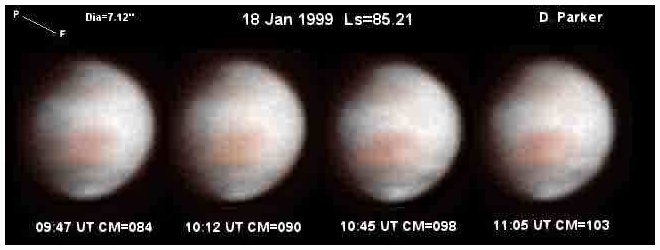
Figure 5-16. Ground-based images of Mars showing brilliant and wide cloud bands across equator zone. Image by D. Parker.
WHITE AREAS: METEOROLOGY?
Astronomers describe so-called white areas observed on Mars as bright patches of light most often seen in the desert regions of the Red Planet. They are generally bright in all colors and conspicuous in integrated light (no filters); however, we must analyze this phenomenon before jumping to conclusions. The nature of white areas, as described by the past A.L.P.O. Mars Section Recorder, Chick Capen, should be discussed at length. A brief description paraphrasing Capen is as follows:
‘A white area is a most delicate and challenging feat of observation. Detection of atmospheric volatiles at the boundary between the Martian atmosphere and its surface can be seen with aid of color filters. In this volatile regime, ice fogs and frosts, often called bright patches, can be distinguished from elevated clouds by means of comparing their relative brightness and boundary definitions as seen with the aid of blue, blue green, green, and yellow filters. If the suspect bright feature appears brighter in blue light than it does in green or yellow light, it is most likely an atmospheric cloud. If it is brighter and better defined in blue-green light than in blue or yellow light, it is probably ice-fog contiguous to the surface. If the patch appears brighter with sharp boundary in green and yellow light and is not well seen in blue light, it can be identified as surface frost.’The diurnal behavior of the surface boundary-layer and its location also helps to distinguish it from clouds and limb haze. Fogs and frosts form in the chill of the Martian night, rotate with the planet, dissipate in the morning sunlight and usually disappear by local noon. Fogs normally form in valleys, in fossae (linear depressions), basins, and on upper slopes. Frosts are usually noted on cool, light albedo features, plana (plateaus), montes (mountains), and floors of large craters. Because these volatiles are topographically controlled the discovery of their locations and seasonal occurrence is most important to the study of Martian weather patterns and areography.
Ground frosts are tricky and their nature is difficult to determine. When surface frost deposits are seen near the planet’s limb sunlight is reflected at an oblique angle, or not directly back to the observer. These deposits will then appear slightly darker than they would if sunlight was directly reflected at the observer. If that same deposit were nearer to the noon hour angle then more sunlight would reflect back and it would appear brighter.
On the other hand, if the area is atmospheric, i.e., an ice-fog or dense particulate matter suspended in the “air,” etc., sunlight would be scattered by the particles and would appear brighter -- even if the area were viewed at an oblique angle to the sun. Atmospheric white areas, as in the case of the so-called limb arcs, tend to be spread out over larger areas and thin out near its edges. Therefore, atmospheric white areas will appear to have defused boundaries. Surface white areas tend to have sharper boundaries, as one might expect.
At the telescope we can prove this by using different colored filters to observe bright patches and record their reactions over a period of a few hours. One expects to see this scenario play out right before their eyes. As the white area moves away from the morning limb its intensity should increase in blue light and at some point, during late morning hours when the deposit has sublimed away, will decrease intensity in red and green light.
If there are dust particles present then the white area will brighten in red light as well. Many of the limb arcs we see a day or so after a dust storm starts and contains a higher dust component. The appearance of a sudden limb arc may be an indicator of an unreported dust storm in progress. The bright, yellowish red haze over the polar regions is another indicator of possible dust activity somewhere on the globe of Mars. Dust streaks within the polar hood or adjacent to the polar cap edge may indicate dust clouds in the polar region. A dust cloud within the polar region will be red in color so it will be brighter in red light, and the cap will be bright as well. In green light this same streak will appear darker (green compliments red light) and will indicate a dust streak.
If the ice crystals form “hoar frost” then they tend to clump up into irregular shaped piles. Small piles of material at low sun angles will cast multiple shadows and the accumulated effect is to darken the surface area. If these frost despots are located near the polar cap then they will appear even darker. Some say this is a result of the so-called contrast effect. It is most likely the result of irradiation in the observer’s eye.
Furthermore, if the piles contain less frost material and more ice crystals then some reflection from “glare-ice” platelets may very well brighten the piles and render the areas brighter. Reflected Sunlight will most likely show up in our eyepiece bright in all colors.
Ice or frost can easily form on surface materials. When H 2 O or CO 2 vapors reach their respective freezing point then condensation begins onto any near by surface. On Earth the “dew point” defines when dewing occurs. When the temperature equals the dew point then fog and dewing may begin in the air or on a cold surface. This also applies to atmospheric condensates close to the Martian surface, except water droplets will not form at the pressure of Mars’ atmosphere. When the temperature of the water vapor floating a few feet above the surface drops below the freezing point and begins to accumulate a condition called ice-fog is possible. Ice-fogs may persist when the winds near the surface will not allow the condensates to fall to the surface. A recent spacecraft landed a roving vehicle on Mars and images from the camera aboard the tiny “car” revealed light surface winds were present down to a few inches in altitude.
We may stop short of calling it snow; however, surface deposits appear as power-like snow drifts as we have seen in Viking Lander images. This is not like the snowflakes or beautifully designed web-like crystals as it is often portrayed. This type of “snow” forms as an irregular shaped crystal that is similar in shape to beach sand or platelets. A snowstorm on Mars is not likely to look like snowflakes falling from some cloud, but would just suddenly appear on the surface in the early morning sunlight.
At any rate, these white areas are well worth study and close attention by observers to color and color filters reactions are important in this study. The views of Mars though a telescope can be intriguing, but the small disk of the planet makes it a difficult object to study. It is also a bright planet.
Those who photograph the planets are well aware that the intrinsic intensity of the surface of Mars is brighter than any other planet. Exposure calculations require a higher albedo coefficient in the equations for Mars. While Venus or Jupiter may appear brighter to the observer, it is Mars that reflect more sunlight per square meter than the other planets. Venus is apparently brighter due to the closeness and bright albedo of its clouds. Jupiter is just larger and reflects back to us a larger area of reflected light. The human eye utilizing color filters can also detect this difference
Compare Clouds of Mars with Earth
In the Earth’s atmosphere clouds often form on the windward side of mountains and are classified as Orographic Clouds. Orographic clouds are clouds that develop in response to the forced lifting of air by the earth’s topography, such as mountains, and fall into the following general categories:
Conjoined orographic clouds - covers entire mountain, forms on windward side.
Orographic Cumulus fractus – usually covering mountain range, large area of clouds covering both windward and lee sides of mountains.
Orographic Stratocumulus and Altocumulus (wave clouds) – form on the lee side of a mountain.
Pileus (Latin for "skullcap") is a smooth cloud found attached to either a mountain top or growing cumulus tower.
Ironically Capen wrote in ALPO Mars Section newsletter and Journal, with similar comments by Lowell astronomer Leonard Martin, that this phenomenon had not been detected by our spacecraft camera filter systems in the 380-420 nm range; further deepening the mystery. A reasonable and recent description of “violet clearing” can be found in "The opposition of Mars, 2001: Part I," by Richard McKim, J. Br. Astron. Assoc. 119, 3, 2009, pp 113-114. https://alpo-astronomy.org/jbeish/mars20011.pdf
The clearing can be limited to only one hemisphere and can vary in intensity from 0 (no surface features detected) to 3 (surface features can be seen also in white light). The Wratten 47 filter or equivalent is the standard for analyzing blue clearing. Normally the surface (albedo) features of Mars appear vague through light blue filters, such as the Wratten 80A. With a Wratten 47 dark blue or violet (380-420 nm) filter, the disk usually appears featureless except for clouds, hazes, and the polar caps.
References
Beish, J.D., and D.C. Parker (1990). "Meteorological Survey of Mars, 1968-1985," Journal of Geophysical Research, Vol. 95, B9, pp. 14567-14675. August 20.
Beish, J.D., “Meteorological Survey of Mars For Opposition Years 1965 – 1995,” The ALPO Computing Section Internet Web Page, November 1999. ( http://www.m2c3.com/alpocs/tdl1999/meterological110199/MOM.html )
Capen, C.F. (1984). "A Guide to Observing Mars-I." J.A.L.P.O., Vol 30 (April), 172-176, and Nos. 9-10 (August), 186-190.
Capen, C.F. (1986). "An Excellent Year for Mars." Sky and telescope Magazine, Vol. 71, No. 6 (June), 592-596.
A.S. Hale, et al, (2003), "WATER ICE CLOUDS IN THE MARTIAN ATMOSPHERE: A COMPARISON OF TWO METHODS," Lunar and Planetary Science XXXIV ( http://www.lpi.usra.edu/meetings/lpsc2003/pdf/1657.pdf)
A.S. Hale, et al, (2005), "WATER ICE CLOUDS IN THE MARTIAN ATMOSPHERE: A VIEW FROM MGS TES," Lunar and Planetary Science XXXVI ( http://www.lpi.usra.edu/meetings/lpsc2005/pdf/1083.pdf )
Slipher, E.C. 1962. The Photographic Story of Mars. 84-87, 156-157. Northland Press Flagstaff.
M. J. Wolff, et al, (1999),
"Some Characteristics of the Martian Aphelion Global
Cloud Belt," THE FIFTH INTERNATIONAL CONFERENCE ON MARS,
CIT, JPL, LPI, NASA, PASADENA, CALIFORNIA (
http://mars.jpl.nasa.gov/mgs/sci/fifthconf99/6173.pdf
)